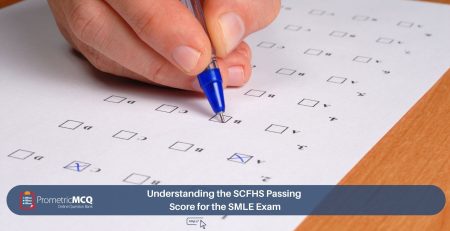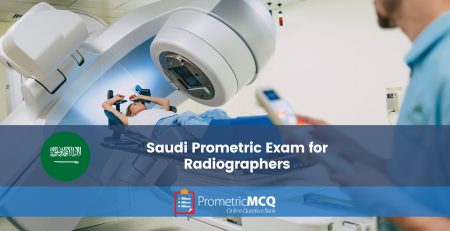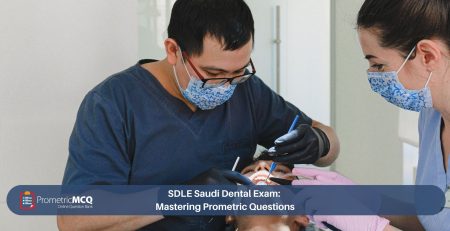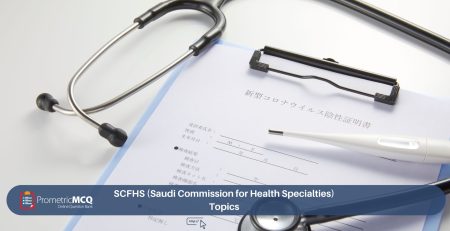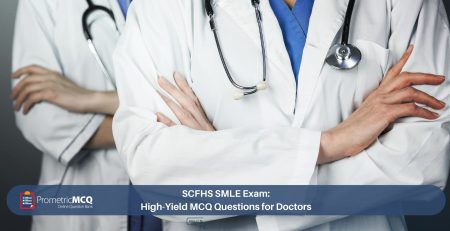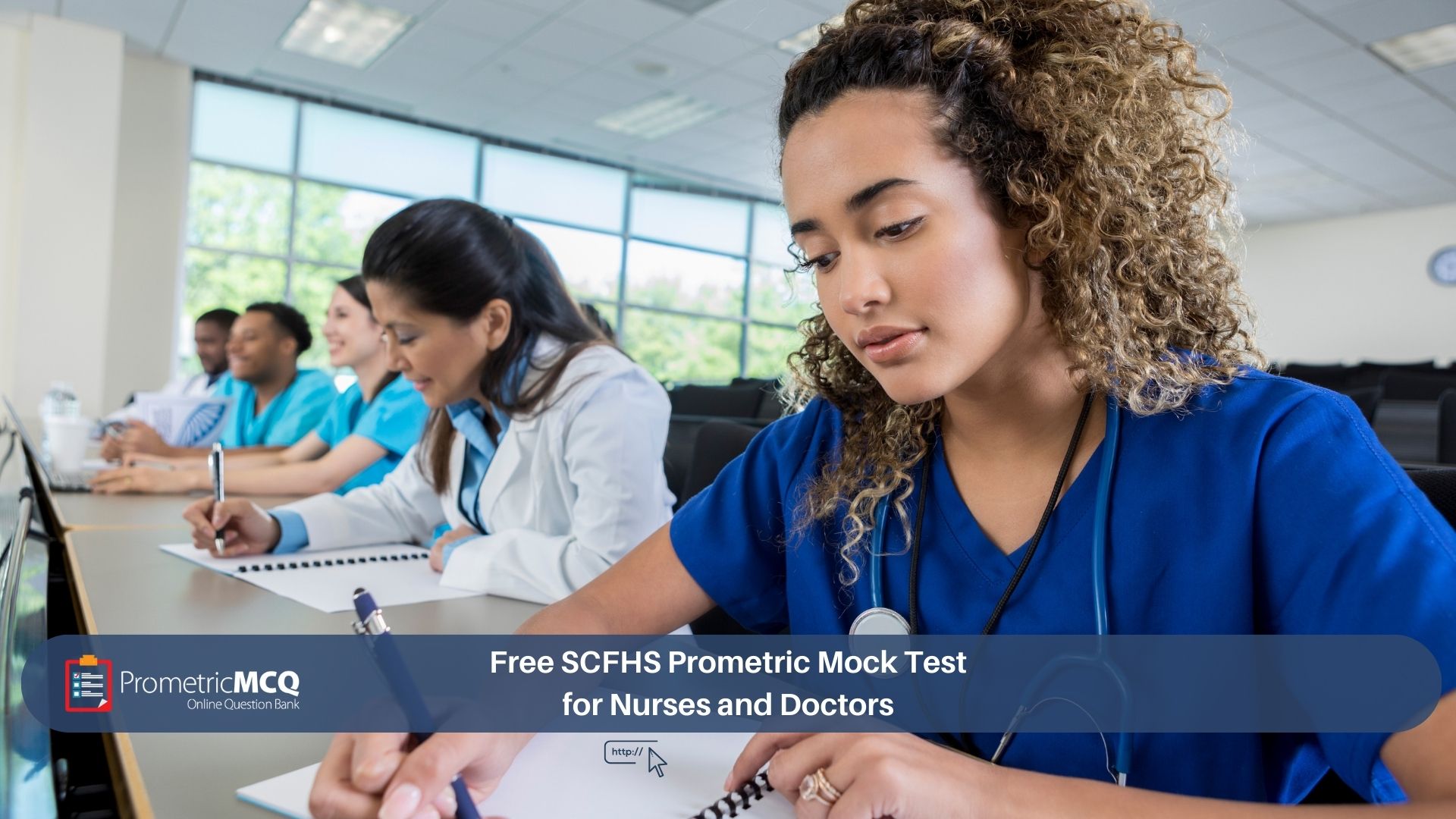
Free SCFHS Prometric Mock Test for Nurses and Doctors
fatima@prometricmcq.com2025-09-17T20:30:14+00:00Table of Contents
ToggleFree SCFHS Prometric Mock Test for Nurses & Doctors (2025 Guide)
For doctors and nurses worldwide, securing a license to practice in the Kingdom of Saudi Arabia represents a pinnacle of professional achievement. The Saudi Commission for Health Specialties (SCFHS) Prometric exams—the Saudi Nurse Licensing Exam (SNLE) for nurses and the Saudi Medical Licensing Exam (SMLE) for doctors—are the rigorous gateways to this prestigious career path. These exams are meticulously designed to test not just your factual knowledge, but your ability to apply it through sharp clinical reasoning and sound judgment under pressure.
While textbooks and review materials build your foundation, the single most powerful tool for exam success is realistic simulation. A high-quality mock test is the ultimate diagnostic tool in your preparation arsenal. It bridges the gap between knowing the material and being able to apply it in the fast-paced, high-stakes environment of the actual Prometric exam. It’s where you hone your time management, identify hidden weaknesses, and build the confidence needed to excel.
This ultimate guide provides just that: a comprehensive, free SCFHS Prometric mock test for both nurses and doctors. We have curated a collection of high-yield, exam-style Multiple-Choice Questions (MCQs) complete with in-depth, expert rationales. This is more than a list of questions; it’s an interactive learning experience designed to sharpen your skills, followed by a strategic guide on how to analyze your performance and a detailed FAQ section. This is your essential resource for turning preparation into a guaranteed pass.
Key Takeaways for Exam Success
- Simulation is Key: A mock test is the best way to replicate the pressure and timing of the real exam.
- Analyze, Don’t Just Score: Your goal isn’t just to get a score, but to understand *why* you got questions right or wrong. The rationales are where true learning happens.
- Identify Your Weaknesses: A mock test is a diagnostic tool. It will clearly show you which clinical areas need more of your attention.
- Master Time Management: The SCFHS exams are long. Practicing with a mock test helps you perfect your pacing to ensure you answer every question.
- Build Unshakeable Confidence: Successfully navigating a challenging mock test is the best way to reduce exam-day anxiety and walk into the test center with confidence. Our guide on how to pass the Saudi SCFHS exam provides a complete strategy.
Part 1: Free SCFHS Nursing Prometric Mock Test (SNLE)
This section contains 15 high-yield MCQs designed to mirror the style and difficulty of the Saudi Nurse Licensing Exam (SNLE). Time yourself: aim to complete this section in 18 minutes. Answer all questions before reviewing the detailed rationales below.
SNLE Mock Test Questions
1. A nurse is assessing a patient who is 12 hours post-thyroidectomy. The patient complains of tingling around the mouth. The nurse then inflates a blood pressure cuff on the patient’s arm and observes a carpal spasm. This finding should be documented as which of the following?
- Chvostek’s sign
- Trousseau’s sign
- Homans’ sign
- Kernig’s sign
2. The nurse has just received the morning report. Which patient should be assessed first?
- A patient with pneumonia with a temperature of 38.6°C and a productive cough.
- A patient scheduled for a colonoscopy at 10:00 AM who is asking for a cup of coffee.
- A patient with a new diagnosis of diabetes mellitus who has a fasting blood glucose of 180 mg/dL.
- A patient receiving a blood transfusion who is complaining of lower back pain and has a temperature of 38.9°C.
3. A physician orders 1000 mL of 0.9% Normal Saline to be infused over 8 hours. The IV tubing has a drop factor of 15 gtt/mL. The nurse should set the manual IV infusion to run at how many drops per minute?
- 21 gtt/min
- 31 gtt/min
- 42 gtt/min
- 50 gtt/min
4. A patient with a history of heart failure is prescribed furosemide 40 mg IV push. The nurse should closely monitor which laboratory value?
- Serum Sodium
- Serum Potassium
- Serum Calcium
- Serum Magnesium
5. A nurse is preparing to administer insulin lispro to a patient with type 1 diabetes. When must this insulin be administered?
- 30-60 minutes before a meal
- Within 15 minutes of a meal
- Only when the blood glucose is above 200 mg/dL
- At bedtime to control basal glucose levels
6. A patient is placed on airborne precautions due to suspected pulmonary tuberculosis. Which of the following is a mandatory component of these precautions?
- The nurse must wear a surgical mask when entering the room.
- The patient must be placed in a positive-pressure room.
- The nurse must wear a fit-tested N95 respirator when entering the room.
- Visitors must wear a gown and gloves at all times.
7. A patient who had a stroke has difficulty swallowing (dysphagia). Which nursing intervention is the highest priority?
- Providing the patient with a variety of food textures to stimulate swallowing.
- Encouraging the patient to drink thin liquids through a straw.
- Placing the patient in a high-Fowler’s position for all meals.
- Offering frequent oral care to prevent dry mouth.
8. A nurse is caring for a client with a deep vein thrombosis (DVT) who is receiving a continuous heparin infusion. The patient’s aPTT is 110 seconds. What is the nurse’s priority action?
- Administer the next dose of heparin as scheduled.
- Stop the heparin infusion and notify the physician.
- Decrease the heparin infusion rate by half.
- Administer protamine sulfate as ordered.
9. A nurse is teaching a patient about taking warfarin. Which statement by the patient indicates a need for further teaching?
- “I will use a soft-bristled toothbrush.”
- “I will eat a large spinach salad every day to stay healthy.”
- “I need to have my blood tested regularly.”
- “I will report any unusual bleeding or bruising to my doctor.”
10. An older adult patient is admitted to the hospital for dehydration. The nurse initiates intravenous fluids. Which assessment finding would indicate a potential complication of this therapy?
- Increased urine output
- Moist mucous membranes
- Crackles in the lung bases
- Improved skin turgor
11. A nurse is delegating tasks to an unlicensed assistive personnel (UAP). Which task is appropriate to delegate?
- Assessing a patient’s pain level after receiving an analgesic.
- Teaching a patient how to use an incentive spirometer.
- Performing a sterile dressing change on a post-operative wound.
- Assisting a stable patient with their morning hygiene.
12. A patient is brought to the emergency department with suspected anaphylaxis after a bee sting. What is the priority medication the nurse should prepare to administer?
- Diphenhydramine (antihistamine)
- Methylprednisolone (corticosteroid)
- Epinephrine (adrenaline)
- Albuterol (beta-agonist)
13. A patient is being discharged after a myocardial infarction. The nurse is providing dietary teaching. Which meal selection indicates that the patient understands the recommended diet?
- Fried chicken, mashed potatoes with gravy, and a biscuit.
- A large pepperoni pizza with extra cheese.
- A cheeseburger with bacon and a side of french fries.
- Grilled salmon, a baked sweet potato, and steamed green beans.
14. The nurse is caring for a patient with a nasogastric (NG) tube attached to low intermittent suction. The patient complains of nausea and their abdomen is distended. What is the nurse’s first action?
- Administer an antiemetic as ordered.
- Advance the NG tube by 5 cm.
- Check the patency of the NG tube.
- Notify the physician immediately.
15. A nurse is reviewing the lab results of a patient on long-term lithium therapy for bipolar disorder. Which finding is most concerning?
- Sodium 140 mEq/L
- Lithium level 1.0 mEq/L
- Creatinine 2.5 mg/dL
- White blood cell count 8,000/mm³
SNLE Mock Test: Answers & In-Depth Rationales
1. Correct Answer: B – Trousseau’s sign
A: Chvostek’s sign is another indicator of hypocalcemia, but it involves tapping on the facial nerve and observing for facial muscle twitching, not inflating a BP cuff.
C: Homans’ sign (calf pain on dorsiflexion) is an unreliable indicator of deep vein thrombosis (DVT).
D: Kernig’s sign (inability to straighten the leg when the hip is flexed) is a sign of meningeal irritation.
2. Correct Answer: D – A patient receiving a blood transfusion who is complaining of lower back pain and has a temperature of 38.9°C.
A: Fever and a productive cough are expected findings for pneumonia. This patient needs care, but is not as acutely unstable as the patient with a transfusion reaction.
B: This is an issue of patient education and procedure preparation, not a life-threatening physiological problem.
C: A fasting glucose of 180 is elevated but not a critical value requiring immediate intervention in a new diabetic.
3. Correct Answer: B – 31 gtt/min
Step 1: Convert hours to minutes: 8 hours * 60 min/hour = 480 minutes.
Step 2: Apply the formula: (1000 mL * 15 gtt/mL) / 480 min = 15000 / 480 = 31.25 gtt/min.
Step 3: Round to the nearest whole number, which is 31 gtt/min.
4. Correct Answer: B – Serum Potassium
A, C, D: While furosemide can cause disturbances in other electrolytes like sodium, calcium, and magnesium, the most common and clinically significant effect is potassium loss.
5. Correct Answer: B – Within 15 minutes of a meal
A: 30-60 minutes is the administration window for short-acting (Regular) insulin, not rapid-acting.
C: Lispro is a prandial (mealtime) insulin, not a correction insulin used only for high blood sugar.
D: Long-acting insulins (like glargine or detemir) are used at bedtime to provide basal coverage.
6. Correct Answer: C – The nurse must wear a fit-tested N95 respirator when entering the room.
A: A surgical mask is for droplet precautions, not airborne.
B: The patient must be in a negative-pressure room, not positive-pressure (which is for immunocompromised patients).
D: Gown and gloves are part of contact precautions, not the primary requirement for airborne precautions unless contact with bodily fluids is anticipated.
7. Correct Answer: C – Placing the patient in a high-Fowler’s position for all meals.
A: The patient should be given foods of a specific, prescribed consistency (often pureed or soft), as determined by a speech-language pathologist. A variety of textures could increase aspiration risk.
B: Thin liquids are the most difficult to control and the easiest to aspirate. They are often contraindicated or require a thickening agent.
D: Oral care is important for hygiene but does not take priority over preventing aspiration.
8. Correct Answer: B – Stop the heparin infusion and notify the physician.
A & C: Continuing or decreasing the infusion would be unsafe as the level is already dangerously high.
D: Protamine sulfate is the antidote for heparin, but it would only be administered based on a specific physician’s order after the situation is assessed. The priority nursing action is to stop the source of the problem.
9. Correct Answer: B – “I will eat a large spinach salad every day to stay healthy.”
A, C, D: These are all correct statements and indicate good understanding. Using a soft toothbrush prevents gum bleeding, regular blood tests (INR) are mandatory, and reporting bleeding is a critical safety measure.
10. Correct Answer: C – Crackles in the lung bases
A, B, D: Increased urine output, moist mucous membranes, and improved skin turgor are all signs that the IV fluid therapy is working correctly and resolving the dehydration.
11. Correct Answer: D – Assisting a stable patient with their morning hygiene.
A, B, C: These tasks all require the professional skills of a registered nurse. Assessment (A), patient teaching (B), and sterile procedures (C) are core nursing responsibilities and cannot be delegated to a UAP.
12. Correct Answer: C – Epinephrine (adrenaline)
A & B: Antihistamines and corticosteroids are second-line treatments. They help with the cutaneous symptoms (like hives) and prevent a delayed reaction, but they do not act quickly enough to reverse the life-threatening hypotension and bronchoconstriction.
D: Albuterol can help with bronchospasm but does not address the systemic vasodilation and shock.
13. Correct Answer: D – Grilled salmon, a baked sweet potato, and steamed green beans.
A, B, C: These options are all high in sodium, saturated fat, and/or trans fats (fried foods, processed meats like pepperoni and bacon, excessive cheese) and are contraindicated for a patient with heart disease.
14. Correct Answer: C – Check the patency of the NG tube.
A: Administering an antiemetic treats the symptom (nausea) but does not fix the root cause of the problem, which is the non-functioning tube.
B: Advancing the tube is not indicated and could cause harm.
D: The nurse should perform a basic assessment and intervention (checking patency) before notifying the physician.
15. Correct Answer: C – Creatinine 2.5 mg/dL
A: Sodium of 140 is normal. The nurse should monitor sodium as low sodium can increase lithium levels, but this value is normal.
B: A lithium level of 1.0 is within the therapeutic range (typically 0.6-1.2 mEq/L for maintenance).
D: The WBC count is normal.
Part 2: Free SCFHS Medical Prometric Mock Test (SMLE)
This section contains 15 high-yield MCQs designed to mirror the style and difficulty of the Saudi Medical Licensing Exam (SMLE). Time yourself: aim to complete this section in 18 minutes. Answer all questions before reviewing the detailed rationales below.
SMLE Mock Test Questions
1. A 65-year-old male presents to the emergency department with a 2-hour history of crushing substernal chest pain radiating to his left arm. An EKG shows ST-segment elevation in leads II, III, and aVF. Which coronary artery is most likely occluded?
- Left Anterior Descending (LAD) artery
- Left Circumflex (LCX) artery
- Right Coronary Artery (RCA)
- Posterior Descending Artery (PDA)
2. A 30-year-old female presents with a palpable, painless, firm, and highly mobile mass in the upper outer quadrant of her right breast. She states it has been present for several months without change. What is the most likely diagnosis?
- Invasive ductal carcinoma
- Fibroadenoma
- Fat necrosis
- Ductal carcinoma in situ (DCIS)
3. A 4-year-old boy is brought to the clinic with a 3-day history of high fever, conjunctivitis, a “strawberry tongue,” and a diffuse maculopapular rash. On examination, he has cervical lymphadenopathy and erythema of the palms and soles. What is the most critical treatment to prevent long-term complications?
- Intravenous antibiotics
- Oral corticosteroids
- Intravenous immunoglobulin (IVIG) and aspirin
- Acetaminophen and supportive care
4. A 25-year-old male involved in a motor vehicle accident is brought to the ER. His blood pressure is 80/40 mmHg, heart rate is 130 bpm, and he has a distended abdomen that is tender to palpation. He has clear breath sounds bilaterally. What is the most likely source of his hypotension?
- Tension pneumothorax
- Cardiac tamponade
- Intra-abdominal hemorrhage
- Neurogenic shock
5. A 70-year-old patient with a history of atrial fibrillation treated with warfarin presents with an INR of 9.0 but has no active bleeding. What is the most appropriate initial management?
- Administer Fresh Frozen Plasma (FFP)
- Administer Protamine Sulfate
- Hold warfarin and administer a small dose of oral Vitamin K
- Continue warfarin and recheck INR in 24 hours
6. A 55-year-old woman with a history of GERD presents with progressive dysphagia to solid foods over the past 6 months and significant weight loss. What is the most important next diagnostic step?
- Barium swallow
- Upper endoscopy with biopsy
- 24-hour pH monitoring
- Trial of a high-dose proton pump inhibitor (PPI)
7. A sexually active 22-year-old female presents with purulent cervical discharge and cervical motion tenderness on pelvic exam. A gram stain of the discharge shows gram-negative diplococci. What is the recommended first-line treatment?
- Azithromycin only
- Doxycycline only
- Ceftriaxone only
- Ceftriaxone and Doxycycline
8. A patient is diagnosed with Type 1 Diabetes Mellitus. Which of the following is the primary pathophysiological mechanism of this disease?
- Peripheral insulin resistance
- Autoimmune destruction of pancreatic beta cells
- Increased hepatic glucose production
- Reduced insulin receptor sensitivity
9. A 60-year-old man with a 40-pack-year smoking history presents with a new-onset cough and hemoptysis. A chest X-ray reveals a large central mass. Laboratory tests show a serum sodium of 120 mEq/L. What is the most likely diagnosis?
- Adenocarcinoma of the lung
- Squamous cell carcinoma of the lung
- Small cell lung cancer (SCLC)
- Tuberculosis
10. A 3-year-old child presents with a barking cough and inspiratory stridor, which is worse at night. The child has a low-grade fever. What is the most likely diagnosis?
- Epiglottitis
- Bacterial tracheitis
- Croup (Laryngotracheobronchitis)
- Foreign body aspiration
11. A 40-year-old woman presents with anxiety, palpitations, heat intolerance, and a 10-pound weight loss despite an increased appetite. On exam, she has a fine tremor, lid lag, and a diffusely enlarged, non-tender thyroid gland. Which lab result would be most consistent with this presentation?
- High TSH, Low Free T4
- Low TSH, High Free T4
- High TSH, High Free T4
- Normal TSH, Low Free T4
12. An 80-year-old patient with dementia is brought in from a nursing home with a fever and altered mental status. A urinalysis is positive for leukocyte esterase, nitrites, and many bacteria. The patient is unable to give consent for treatment. What is the most appropriate ethical principle to follow?
- Autonomy
- Beneficence
- Justice
- Non-maleficence
13. A patient presents with right upper quadrant pain that radiates to the right scapula, occurring after fatty meals. An ultrasound reveals gallstones within the gallbladder and a thickened gallbladder wall. What is the diagnosis?
- Choledocholithiasis
- Acute cholecystitis
- Acute pancreatitis
- Peptic ulcer disease
14. A 7-year-old boy presents with periorbital edema and dark, cola-colored urine. His mother states he had a sore throat about two weeks ago. His blood pressure is elevated. This clinical picture is most suggestive of which renal pathology?
- Minimal change disease
- Focal segmental glomerulosclerosis
- Post-streptococcal glomerulonephritis
- IgA nephropathy
15. A patient with known liver cirrhosis presents with confusion and asterixis. What is the first-line treatment for this condition?
- Intravenous albumin
- Spironolactone
- Propranolol
- Lactulose
SMLE Mock Test: Answers & In-Depth Rationales
1. Correct Answer: C – Right Coronary Artery (RCA)
A: Occlusion of the LAD artery typically causes an anterior wall MI, with ST-elevation in leads V1-V4.
B: Occlusion of the LCX artery usually causes a lateral wall MI, with ST-elevation in leads I, aVL, V5, and V6.
D: The PDA is typically a branch of the RCA, so RCA occlusion is the primary answer.
2. Correct Answer: B – Fibroadenoma
A & D: Breast cancers are typically hard, irregular, and fixed to underlying tissues, not highly mobile.
C: Fat necrosis can present as a firm mass but is usually associated with a history of trauma to the breast.
3. Correct Answer: C – Intravenous immunoglobulin (IVIG) and aspirin
A: Kawasaki disease is not a bacterial infection, so antibiotics are ineffective.
B: Corticosteroids may be used in refractory cases but are not the first-line treatment.
D: Supportive care alone does not prevent the life-threatening cardiac complications.
4. Correct Answer: C – Intra-abdominal hemorrhage
A: A tension pneumothorax would present with absent breath sounds on one side and tracheal deviation.
B: Cardiac tamponade would present with Beck’s triad (hypotension, JVD, muffled heart sounds).
D: Neurogenic shock (from a spinal cord injury) would present with hypotension but also bradycardia, not tachycardia.
5. Correct Answer: C – Hold warfarin and administer a small dose of oral Vitamin K
A: FFP is used for rapid reversal in cases of severe or life-threatening bleeding.
B: Protamine sulfate is the antidote for heparin, not warfarin.
D: Continuing warfarin with such a high INR would be extremely dangerous and increase the risk of major hemorrhage.
6. Correct Answer: B – Upper endoscopy with biopsy
A: A barium swallow can be useful to evaluate motility but cannot rule out cancer and will be followed by endoscopy anyway.
C & D: These are used for diagnosing GERD, but in the presence of alarm symptoms, a more definitive investigation for malignancy is required first.
7. Correct Answer: D – Ceftriaxone and Doxycycline
A, B, C: Monotherapy is no longer recommended due to increasing antibiotic resistance and the high rate of co-infection.
8. Correct Answer: B – Autoimmune destruction of pancreatic beta cells
A, C, D: Insulin resistance, increased hepatic glucose output, and reduced receptor sensitivity are all key components of the pathophysiology of Type 2 Diabetes Mellitus, not Type 1.
9. Correct Answer: C – Small cell lung cancer (SCLC)
A: Adenocarcinoma is typically a peripheral lesion and is less associated with SIADH.
B: Squamous cell carcinoma is also central but is more commonly associated with hypercalcemia as a paraneoplastic syndrome.
D: Tuberculosis can cause lung lesions and hyponatremia, but a discrete central mass is more typical of cancer.
10. Correct Answer: C – Croup (Laryngotracheobronchitis)
A: Epiglottitis is a bacterial infection that presents more acutely with high fever, drooling, a toxic appearance, and a “tripod” posture; a barking cough is not typical.
B: Bacterial tracheitis is a more severe infection, often following croup, with higher fever and a more toxic appearance.
D: Foreign body aspiration would typically have a sudden onset of choking and coughing, not a prodrome of fever.
11. Correct Answer: B – Low TSH, High Free T4
A: This pattern (High TSH, Low T4) is seen in primary hypothyroidism.
C: This pattern (High TSH, High T4) is seen in a secondary hyperthyroidism, caused by a TSH-secreting pituitary adenoma, which is very rare.
D: This pattern is not typical for any common thyroid disorder.
12. Correct Answer: B – Beneficence
A: Autonomy is the patient’s right to make their own decisions, which this patient is unable to do.
C: Justice refers to the fair distribution of healthcare resources.
D: Non-maleficence means “do no harm.” While treatment adheres to this, beneficence (acting for the patient’s good) is the more active and guiding principle in this specific scenario.
13. Correct Answer: B – Acute cholecystitis
A: Choledocholithiasis refers to a stone in the common bile duct, which would more likely present with jaundice.
C: Acute pancreatitis presents with epigastric pain radiating to the back and would be diagnosed with elevated lipase/amylase.
D: Peptic ulcer disease typically causes epigastric pain related to meals, but not specifically fatty meals, and would not have these ultrasound findings.
14. Correct Answer: C – Post-streptococcal glomerulonephritis
A: Minimal change disease is the most common cause of nephrotic syndrome in children and presents with massive proteinuria and edema but not typically gross hematuria and hypertension.
B & D: These are other causes of glomerulonephritis, but the preceding streptococcal infection makes PSGN the most likely diagnosis.
15. Correct Answer: D – Lactulose
A: IV albumin is used in the management of spontaneous bacterial peritonitis or hepatorenal syndrome.
B: Spironolactone is a diuretic used to manage ascites in cirrhosis.
C: Propranolol is a beta-blocker used for primary prophylaxis of variceal bleeding.
How to Analyze Your Mock Test Performance: A 5-Step Guide
Completing the mock test is only the first step. The real learning comes from a deep analysis of your performance. Follow this process to extract the maximum value.
- Calculate Your Score: Be honest with your grading. Calculate the percentage you got correct for each section. If your score is below 70%, it’s a clear sign you need to intensify your content review and MCQ practice.
- Create an Error Log: This is the most crucial step. For every question you got wrong (and every question you guessed correctly), write it down in a notebook or spreadsheet. Categorize the error: Was it a pure knowledge gap? Did you misread the question? Did you fall for a distractor? Did you run out of time?
- Deep Dive into the Rationale: Don’t just read the correct answer. Read the full rationale for why that option is correct and, just as importantly, why the other options (the distractors) are incorrect. This teaches you to differentiate between good, better, and best answers.
- Identify Patterns of Weakness: After logging 20-30 errors, you will see patterns emerge. Are you consistently missing pharmacology questions? Are you struggling with prioritization? This analysis tells you exactly where to focus your remediation efforts.
- Create a Targeted Remediation Plan: Use your error log to create a study plan for the next week. If you were weak in cardiology, dedicate the next two days to reviewing that content and doing 100 cardiology-specific MCQs. This targeted approach is far more effective than random studying.
Frequently Asked Questions (FAQs) for the SCFHS Exams
Both exams are scored out of 800, with an official passing score of 500 for the SNLE (Nurse Specialist) and SMLE (Medical Intern/GP). This translates to approximately 62.5%. However, due to scaled scoring, the best strategy is to aim for 70-75% on practice tests to ensure you pass comfortably.
These questions are designed to closely mimic the format, style, and content of the real SCFHS Prometric exams. They are case-based and require a high level of clinical reasoning, focusing on the high-yield topics that are most frequently tested.
For nurses (SNLE), the most critical areas are prioritization of care, patient safety, infection control, and pharmacology calculations. For doctors (SMLE), the focus is on the diagnosis and management of common, high-impact conditions in internal medicine, surgery, pediatrics, and OB/GYN, along with a strong understanding of ethics.
It is recommended to take at least 3 to 5 full-length, timed mock exams during the final phase of your preparation (the last 3-4 weeks). This builds the mental stamina required for a long exam and helps perfect your time management skills.
Passing the Prometric exam is the first major step. You must then complete your professional registration on the SCFHS online portal, “Mumaris Plus.” A mandatory part of this is the Primary Source Verification (PSV) of your credentials by the DataFlow Group. Our guide on the SCFHS DataFlow process provides a detailed walkthrough.
Yes, absolutely. While some core medical knowledge overlaps, the scope of practice is different, and the exams are tailored accordingly. It is essential to use a question bank specifically designed for your profession. You can find dedicated resources for the SCFHS Nursing Exam and the Saudi Medical Licensing Exam (SMLE).
The single source of truth is the official Saudi Commission for Health Specialties website. You can find exam blueprints, candidate handbooks, and official announcements at www.scfhs.org.sa.
The only way to improve your speed is through practice with timed MCQs. Initially, practice in untimed mode to master the content. Then, transition to timed blocks of 50 questions, aiming to complete them in 60 minutes. This builds the pace you need for the real exam.
The biggest mistake is passive learning—simply reading books or watching videos without actively testing your knowledge. Success in the SCFHS exams comes from active recall, which is best achieved by doing thousands of practice questions and meticulously analyzing the rationales.
No, there is no negative marking on the SCFHS Prometric exams. You should answer every single question, even if you have to make an educated guess. Use the process of elimination to increase your chances.
Conclusion: From Mock Test to Real Success
This free mock test is more than just a practice tool; it’s the beginning of a strategic, active, and intelligent approach to your SCFHS exam preparation. By embracing the challenge, analyzing your performance with a critical eye, and using that analysis to guide your studies, you transform yourself from a passive learner into an active problem-solver. This is the mindset that the SCFHS is looking for, and it’s the mindset that will lead you to a first-attempt pass. Trust in the process, commit to the practice, and you will be well on your way to a successful and rewarding healthcare career in the Kingdom of Saudi Arabia.
Ready to Move Beyond the Mock Test?
Our premium MCQ packages for the SNLE and SMLE feature thousands of high-yield questions, detailed expert rationales, and performance analytics to guarantee you are fully prepared to ace your exam.





